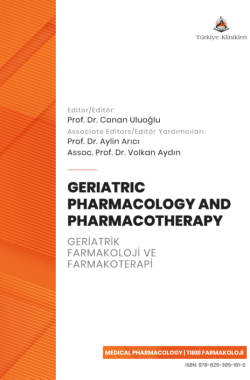General Aspects of Drug Management in the Geriatric Patient
Nermin KARAKURTa , Hacer DOĞAN VARANa
aGazi University Faculty of Medicine, Department of Internal Medicine, Division of Geriatrics, Ankara, Türkiye
Karakurt N, Doğan Varan H. General aspects of drug management in the geriatric patient. In: Uluoğlu C, ed. Geriatric Pharmacology and Pharmacotherapy. 1st ed. Ankara: Türkiye Klinikleri; 2023. p.15-9.
ABSTRACT
Chronic diseases and polypharmacy increase with age. Physiological reserves and body composition changes that occur with aging affect the pharmacokinetics and pharmacodynamics of drugs. Polypharmacy reduces medication compliance in older people and increases the risk of inappropriate use of medications, adverse drug reactions, drug-drug interactions, falls, cognitive and functional decline, hospitalization, and mortality. Therefore, when organizing drug therapy for older patients, it is essential to review all medications, including any inappropriate herbal use, and organize drug therapy taking into account the individual’s medical and social characteristics. To optimize drug treatment in older patients, it is important to check the treatment scheme for efficacy, identify any inappropriate drugs, drug interactions, and side effects, determine if there are drugs with indications but not prescribed, and inform the patient of any expected side effects.
Keywords: Polypharmacy; drug management; inappropriate medication; elderly
Kaynak Göster
Referanslar
- Ferner RE, Aronson JK. Communicating information about drug safety. BMJ. 2006;333(7559):143-5. [Crossref] [PubMed] [PMC]
- Kurt M, Akdeniz M, Kavukcu E. Assessment of Comorbidity and Use of Prescription and Nonprescription Drugs in Patients Above 65 Years Attending Family Medicine Outpatient Clinics. Gerontol Geriatr Med. 2019;5:2333721419874274. [Crossref] [PubMed] [PMC]
- Bahat G, Bay I, Tufan A, Tufan F, Kilic C, Karan MA. Prevalence of potentially inappropriate prescribing among older adults: A comparison of the Beers 2012 and Screening Tool of Older Person's Prescriptions criteria version 2. Geriatr Gerontol Int. 2017;17(9):1245-51. [Crossref] [PubMed]
- Kucukdagli P, Bahat G, Bay I, Kilic C, Oren MM, Turkmen BO, et al. The relationship between common geriatric syndromes and potentially inappropriate medication use among older adults. Aging Clin Exp Res. 2020;32(4):681-7. [Crossref] [PubMed]
- Onder G, Giovannini S, Sganga F, Manes-Gravina E, Topinkova E, Finne-Soveri H, et al. Interactions between drugs and geriatric syndromes in nursing home and home care: results from Shelter and IBenC projects. Aging Clin Exp Res. 2018;30(9):1015-21. [Crossref] [PubMed]
- Freeland KN, Thompson AN, Zhao Y, Leal JE, Mauldin PD, Moran WP. Medication use and associated risk of falling in a geriatric outpatient population. Ann Pharmacother. 2012;46(9):1188-92. [Crossref] [PubMed]
- By the 2023 American Geriatrics Society Beers Criteria® Update Expert Panel. American Geriatrics Society 2023 updated AGS Beers Criteria® for potentially inappropriate medication use in older adults. J Am Geriatr Soc. 2023;71(7):2052-81. [Crossref] [PubMed]
- O'Mahony D, O'Sullivan D, Byrne S, O'Connor MN, Ryan C, Gallagher P. STOPP/START criteria for potentially inappropriate prescribing in older people: version 2. Age Ageing. 2015;44(2):213-8. Erratum in: Age Ageing. 2018;47(3):489. [Crossref] [PubMed] [PMC]
- Hilmer SN. Calculating and using the drug burden index score in research and practice. Expert Rev Clin Pharmacol. 2018;11(11):1053-5. [Crossref] [PubMed]
- Askari M, Wierenga PC, Eslami S, Medlock S, de Rooij SE, Abu-Hanna A. Assessing quality of care of elderly patients using the ACOVE quality indicator set: a systematic review. PLoS One. 2011;6(12):e28631. [Crossref] [PubMed] [PMC]
- Hanlon JT, Schmader KE. The medication appropriateness index at 20: where it started, where it has been, and where it may be going. Drugs Aging. 2013;30(11):893-900. [Crossref] [PubMed] [PMC]
- Lavan AH, Gallagher P, Parsons C, O'Mahony D. STOPPFrail (Screening Tool of Older Persons Prescriptions in Frail adults with limited life expectancy): consensus validation. Age Ageing. 2017;46(4):600-7. [Crossref] [PubMed]
- Woolcott JC, Richardson KJ, Wiens MO, Patel B, Marin J, Khan KM, et al. Meta-analysis of the impact of 9 medication classes on falls in elderly persons. Arch Intern Med. 2009;169(21):1952-60. Erratum in: Arch Intern Med. 2010;170(5):477. [Crossref] [PubMed]
- Oscanoa TJ, Lizaraso F, Carvajal A. Hospital admissions due to adverse drug reactions in the elderly. A meta-analysis. Eur J Clin Pharmacol. 2017;73(6):759-770. [Crossref] [PubMed]
- Margolis SA, Kelly DA, Daiello LA, Davis J, Tremont G, Pillemer S, et al. Anticholinergic/Sedative Drug Burden and Subjective Cognitive Decline in Older Adults at Risk of Alzheimer's Disease. J Gerontol A Biol Sci Med Sci. 2021;76(6):1037-43. [Crossref] [PubMed]
- Gray SL, Anderson ML, Dublin S, Hanlon JT, Hubbard R, Walker R, et al. Cumulative use of strong anticholinergics and incident dementia: a prospective cohort study. JAMA Intern Med. 2015;175(3):401-7. [Crossref] [PubMed] [PMC]
- Han BH, Sutin D, Williamson JD, Davis BR, Piller LB, Pervin H, et al.; ALLHAT Collaborative Research Group. Effect of Statin Treatment vs Usual Care on Primary Cardiovascular Prevention Among Older Adults: The ALLHAT-LLT Randomized Clinical Trial. JAMA Intern Med. 2017;177(7):955-65. [Crossref] [PubMed] [PMC]

